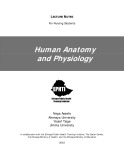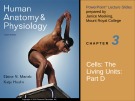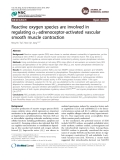
Anatomy and physiology
-
Tài liệu Tiếng Anh trong Y khoa bản rút gọn được các tác giả trình bày dưới dạng song ngữ Anh - Việt. Các chủ đề của tài liệu như giải phẫu học và sinh lý học, hệ tim mạch, hệ thần kinh,... gồm các khái niệm, từ vựng tiếng anh và có dịch nghĩa giúp chúng ta dễ dàng học tập.
 323p
323p  lavender2022
lavender2022
 27-04-2022
27-04-2022
 35
35
 7
7
 Download
Download
-
Human anatomy and physiology is more than just interesting, it is fascinating. To help get the students and instructions involved in the study of this subject, a number of special features are incorporated throughout the lecture note.
 428p
428p  phannguyenhaminhths
phannguyenhaminhths
 18-08-2021
18-08-2021
 26
26
 2
2
 Download
Download
-
This chapter provides knowledge of cell cycle. The main contents of this chapter include all of the following: List the phases of the cell cycle and describe the key events of each phase, describe the process of DNA replication.
 9p
9p  tangtuy07
tangtuy07
 02-04-2016
02-04-2016
 33
33
 2
2
 Download
Download
-
REVIEW ARTICLE Hanna Willander1,2, EriThe BRICHOS domain was initially defined from sequence alignments of the Bri protein associated with familial dementia, chondromodulin associ-ated with chondrosarcoma and surfactant protein C precursor (proSP-C) associated with respiratory distress syndrome and interstitial lung disease (ILD). Today BRICHOS has been found in 12 protein families.
 12p
12p  cosis54
cosis54
 09-12-2012
09-12-2012
 47
47
 3
3
 Download
Download
-
Reactive oxygen species (ROS) were shown to mediate aberrant contractility in hypertension, yet the physiological roles of ROS in vascular smooth muscle contraction have remained elusive. This study aimed to examine whether ROS regulate a1-adrenoceptor-activated contraction by altering myosin phosphatase activities. Methods: Using endothelium-denuded rat tail artery (RTA) strips, effects of anti-oxidants on isometric force, ROS production, phosphorylation of the 20-kDa myosin light chain (MLC20), and myosin phosphatase stimulated by a1-adrenoceptor agonist phenylephrine were examined.
 10p
10p  toshiba23
toshiba23
 18-11-2011
18-11-2011
 54
54
 3
3
 Download
Download
CHỦ ĐỀ BẠN MUỐN TÌM

















